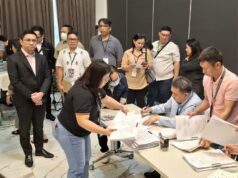Bangko Sentral unfazed by Fed tightening into 2018
By Wilfredo G. Reyes
Managing Editor
YOKOHAMA, JAPAN — The Bangko Sentral ng Pilipinas (BSP), whose Monetary Board will meet for the third time this year on Thursday, will keep its eyes glued to key macroeconomic dials even in the face of mounting views that the US Federal Reserve will speed up policy tightening next year, Deputy Governor Diwa C. Guinigundo said here on Thursday last week. Asked on the expectation aired here last Wednesday by Asian Development Bank (ADB) Chief Economist Yasuyuki Sawada that next year could see up to four US Fed interest rate increases on top of 2017’s projected three, Mr. Guinigundo — one of the contenders for BSP Gov. Amando M. Tetangco, Jr.’s post when he steps down in early July — said “the decision… on monetary policy, emerging trade and fiscal policy in the United States — they are important considerations.”
Mr. Sawada’s views add to those of a Reuters poll of Wall Street bankers in March that bared expectations of at least three more increases in 2018 to add to this year’s three, including the last Fed move that same month the news agency made the survey.
“But what is more important for us when we design monetary policy is to see the emerging price and monetary conditions in the Philippines. We look at how inflation expectations are well-anchored and the weakness or the strength of economic growth in the Philippines,” Mr. Guinigundo said in a BusinessWorld interview in Yokohama on the sidelines of the 50th meeting of the ADB’s Board of Governors.
BSP’s monetary board has so far kept policy steady — save for procedural interest rate tweaks in June last year to pave the way for an interest rate corridor system to better siphon excess liquidity and influence market rates besides — since an increase in September 2014.
Analysts widely expect the BSP to keep policy rates unchanged on Thursday on the back of manageable inflation and firm domestic demand, although some are pricing in as much as two rate hikes within the second half of 2017 to probably move in step with an expected second rate hike by the Fed by June.
“We remain data-dependent. It is difficult to paint yourself in a corner.”
Year-to-date annual Philippine inflation has hovered around BSP projections so far, averaging 3.2% as of April against a 3.4% full-year forecast coming from 2016’s actual 1.8%, although the four-month pace — which continues a marked acceleration that began in September 2016 — is slightly above the midpoint of the central bank’s 2-4% target range.
Multilateral agencies have kept a bullish view on Philippine economic growth prospects, expecting the country to be a leader in Asia and the Pacific.
The country’s 6.9% gross domestic product expansion in 2016 was the fastest in three years since the 7.1% growth in 2013, and the government now wants to sustain this pace at 6.5-7.5% this year and then spur it to 7-8% starting 2018.
The government’s GDP growth projection this year compares to the 6.9% forecast of the World Bank and the United Nations Economic and Social Commission for Asia and the Pacific, the International Monetary Fund’s 6.8% and the Asian Development Bank’s 6.4%.
ON TRUMP AND TAXES
Mr. Guinigundo said mounting expectations of an acceleration in US monetary policy tightening next year bear “[t]he apparent assumption… that the US economy has not only turned the corner but is now more robust.”
“The soft patches of growth have been addressed and the outlook is very, very encouraging,” he noted.
“If that is the premise, then the presumption is that the US economy is strong enough to absorb those seven hikes [this year and next].”
Having said that, Mr. Guinigundo said, it remains to be seen whether US President Donald J. Trump can muster enough bipartisan support for his plan to overhaul his country’s tax system within the year.
“One will have to be very careful when shepherding recovery and restoration of the economic momentum,” he said.
The Fed began its ongoing policy tightening run in December 2015 after nearly a decade of near-zero rates put in place to help the US economy then recuperate from the December 2007-June 2009 “Great Recession.” Since then, it followed its quarter-of-a-basis point hike with increases of similar magnitude in December 2016 and last March. US monetary authorities have been signalling since late last year that three hikes are in store this year, though at a gradual pace.
“You may have a long-term view of how much the economy can absorb in terms of such rate hikes, but that should be subject to actual unfolding of events, particularly both the output side and on the inflation side, especially in light of what the President of the US has been saying: that he wants to spend and spend more,” Mr. Guinigundo said.
“But spending has to be funded, and if funding is going to be done by greater indebtedness of the US economy that may not be sustainable. So i think fiscal reforms are essential and critical here.”
The Philippines is in a similar situation, as the administration of President Rodrigo R. Duterte pushes the first of four packages of its own tax reform program through Congress, starting with the House of Representatives from which all tax measures emanate by law.
The entire program is designed to raise more revenues — in the first package by a net P206.8 billion after cutting personal income tax rates and offsetting this with increases in automobile and fuel excise tax rates — while making the tax burden more equitable in order to help fund public infrastructure spending of up to P9 trillion until 2022, when the current administration ends its term.
After the Finance department submitted the first tax reform package to Congress in September last year and a House bill was filed last January, the Ways and Means committee finally approved a revised version last week after emerging from a six-week break. While it is now headed for plenary approval at the House, the landmark reform — judging by the Senate leaders’ signal — faces even greater scrutiny when the measure reaches the upper chamber. The Executive has wanted mid-year approval by both chambers.
“In the same way… We in the Philippines are saying that we need to catch up in infrastructure and the government has made some pronouncements that we will spend, spend and spend so that we can build build and build,” Mr. Guinigundo said.
“But we want to make sure that we raise the resources to make this possible and we are doing it.”



